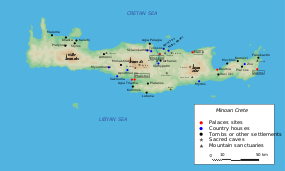
Back Phaistos AF Phaistos ALS Фест BE Фестос Bulgarian Festos Catalan Faistos Czech Festos Danish Phaistos German Φαιστός Greek Festo Spanish
 Map of Minoan Crete | |
| Alternative name | Phaestus |
|---|---|
| Location | Faistos, Heraklion, Crete, Greece |
| Region | The eastern point of a ridge overlooking Messara Plain to the east |
| Coordinates | 35°03′05″N 24°48′49″E / 35.05139°N 24.81361°E |
| Type | Minoan palace and city |
| Area | 8,400 m2 (90,000 sq ft)[2] for the palace. The city extended a few km into the valley below. |
| History | |
| Material | Trimmed blocks of limestone and alabaster, mudbrick, rubble, wood |
| Founded | First settlement dates to about 3000 BCE. First palace dates to about 1850 BCE.[3] New palace dates to around 1700 BCE |
| Periods | Late Neolithic to Late Bronze Age |
| Cultures | Minoan |
| Site notes | |
| Excavation dates | 1894, 1900–1920, 1950–1966, 2000–2004, 2007–present |
| Archaeologists | Antonio Taramelli, Federico Halbherr, Luigi Pernier, Antonio Minto, Doro Levi, Vincenzo La Rosa, Fausto Longo |
| Condition | Tamped soil, stone walkways, hand rails, lightly roofed areas[2] |
| Management | 23rd Ephorate of Prehistoric and Classical Antiquities |
| Public access | Yes |
Phaistos (Greek: Φαιστός, pronounced [feˈstos]; Ancient Greek: Φαιστός, pronounced [pʰai̯stós], Linear B: 𐀞𐀂𐀵 Pa-i-to; Linear A: 𐘂𐘚𐘄 Pa-i-to[1]), also transliterated as Phaestos, Festos and Latin Phaestus, is a Bronze Age archaeological site at modern Faistos, a municipality in south central Crete. It is notable for the remains of a Minoan palace and the surrounding town.
Ancient Phaistos was located about 5.6 km (3.5 mi) east of the Mediterranean Sea and 62 km (39 mi) south of Heraklion. Phaistos was one of the largest cities of Minoan Crete. The name Phaistos survives from ancient Greek references to a city on Crete of that name at or near the current ruins.[4]
- ^ a b [1]Nagy, Gregory, "Greek-like elements in Linear A", Greek, Roman, and Byzantine Studies 4.4, pp. 181-211, 1963
- ^ a b Stratis, James C. (October 2005), Kommos Archaeological Site Conservation Report (PDF), kommosconservancy.org
- ^ LaRosa, Vincenzo (November–December 1995). "A hypothesis on earthquakes and political power in Minoan Crete" (PDF). Annali di Geofisica. 38 (5–6): 883. The 1850 date was proposed by Doro Levi, who did not agree with Evans on every point.
- ^ Privitera, Santo (2011). "Looking for a Home in a Houseless Town: Exploring Domestic Architecture in Final Palatial Ayia Triada". Hesperia Supplements. 44: 263–272.